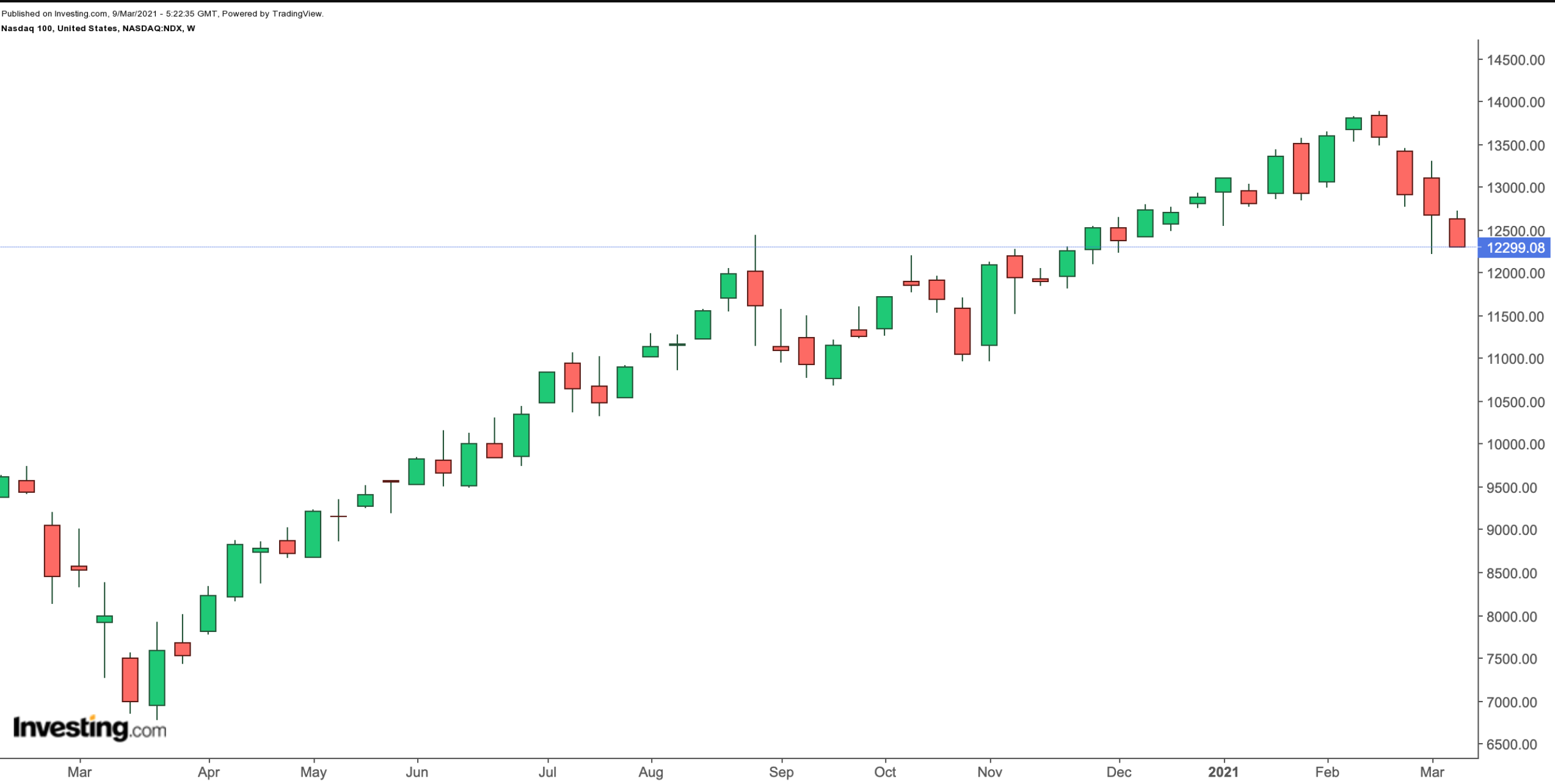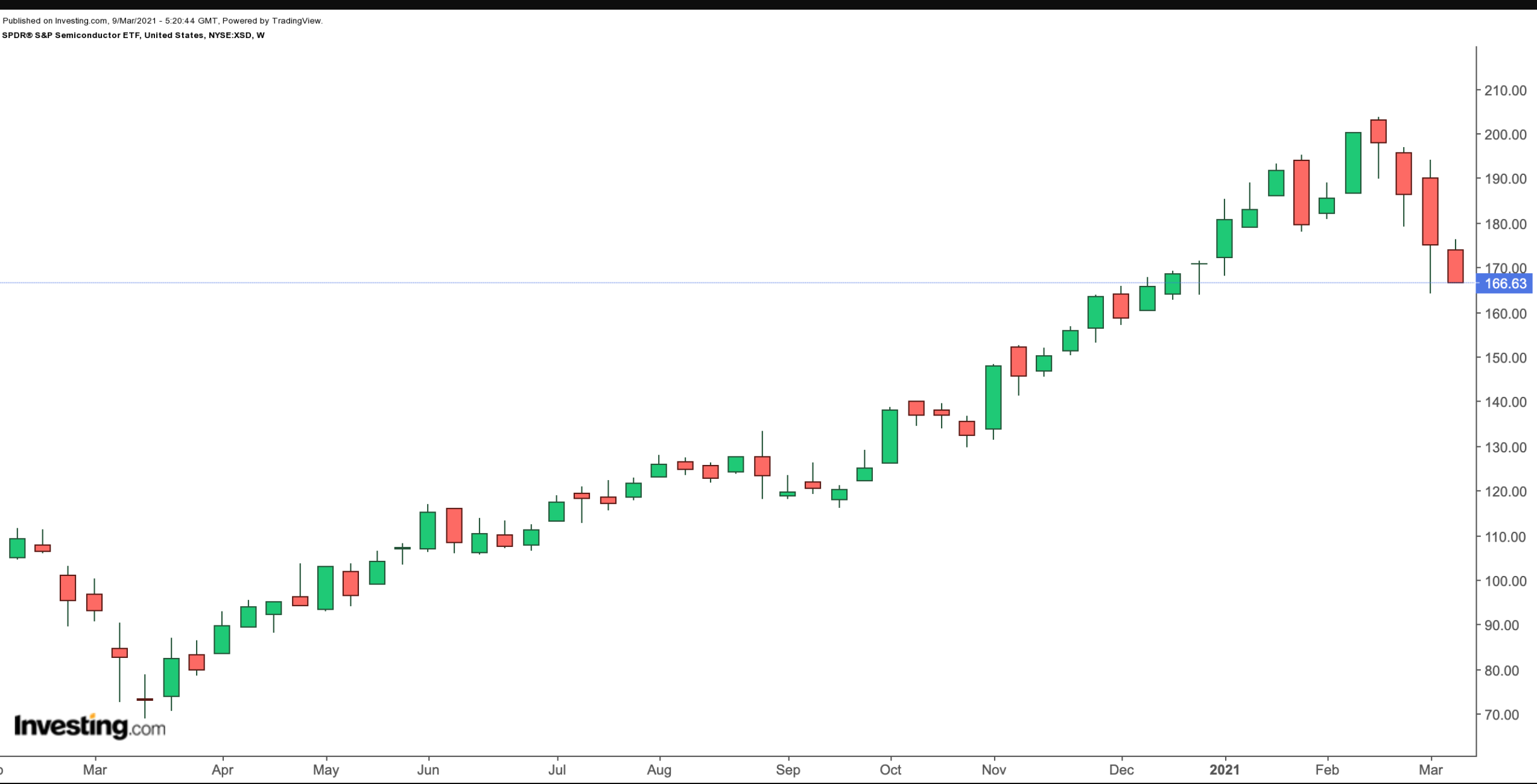Semiconductors are found in every electronic device. From personal computers to smartphones, consumer electronics to automobiles, chips are the "brains" inside every electronic item.
Over the past decade, the gains in the chip industry provided the tailwinds for returns in the technology sector. As a result, several semiconductor names have become darlings of Wall Street. Many of them were among the first stocks to recover from the March 2020 lows.
So far in 2021, the widely followed Philadelphia Semiconductor Index is up about 4% and over the past year, it returned more than 68%. But after hitting a record high in mid-February, the index has come under pressure.

By comparison, the NASDAQ 100 index increased by 46% in the past 12 months. However, YTD, the index is down more than 1%. Its price action in recent days has been similar to that of SOX.

Indeed, recently there has been increased volatility in tech shares, including chip stocks. Several of the semiconductor names that get regular investors attention include:
- Advanced Micro Devices (NASDAQ:AMD) — up about 61% in one year
- Broadcom (NASDAQ:AVGO) — up about 67% in one year
- Intel (NASDAQ:INTC) — up about 9% in one year
- Micron Technology (NASDAQ:MU) — up about 72% in a year
- NXP Semiconductors (NASDAQ:NXPI) — up about 61% in one year
- NVIDIA (NASDAQ:NVDA) — up about 87% in one year
- Qualcomm (NASDAQ:QCOM) — up about 68% in a year
- STMicroelectronics (NYSE:STM) — up about 33% in one year
- Taiwan Semiconductor Manufacturing (NYSE:TSM) — up about 120% in a year
- Texas Instruments (NASDAQ:TXN) — up about 48% in one year
However, we have to highlight that many semiconductor companies, like AMD, do not manufacture their own chips. Instead, they rely on semiconductor foundries (more commonly called a fab). Taiwan Semiconductor Manufacturing (NYSE:TSM) dominates the semiconductor foundry market. Intel (NASDAQ:INTC) is one of the few leading chip companies to manufacture its own chips.
Meanwhile, recent headlines regarding chip shortages have put the sector in the limelight. Soaring sales for computers, smartphones and other personal electronics items during the pandemic has meant increased chip demand.
Such a shortage has different implications for chip-makers as well as companies in different sectors. For instance automakers, like General Motors (NYSE:GM), have decided to cut production and temporarily close plants. Similarly, Sony (NYSE:SNE) has warned the shortage will constrain PlayStation 5 supplies in the coming months.
For chip companies, the effect of these shortages are likely to be mixed. Supply shortages enable most chip-makers to raise prices, which typically means revenue growth. On the other hand, shortages cap the sales potential.
Given the recent decline in prices of many chip shares, March could be an opportune time to enter the segment. New technological developments, such as artificial intelligence (AI), autonomous driving, cloud computing, 5G, the internet of things (IoT) will drive demand so we remain bullish on the future of the semiconductor industry.
Today, we introduce a sectoral exchange-traded fund (ETF) that deserves to be on investors' radar screen.
SPDR S&P Semiconductor ETF
Current Price: $166.63
52-Week Range: $68.95 - $203.60
Dividend Yield: 0.26%
Expense ratio: 0.35% per year
The SPDR® S&P Semiconductor ETF (NYSE:XSD) gives access to 38 semiconductor shares across a range of market capitalizations. As an equal-weight fund, it might be appropriate for investors looking for exposure to mid- and small-cap semiconductor names. We recently discussed how equal-weight ETFs might help diversify long-term portfolios.

The fund, which tracks the S&P Semiconductor Select Industry Index, started trading in January 2006. Assets under management are close to $957 million. Synaptics (NASDAQ:SYNA), which focuses on manufacturing chips used mostly in consumer devices with wireless connectivity, energy group SunPower (NASDAQ:SPWR), Ambarella (NASDAQ:AMBA), which focuses on advanced imaging solutions, Phoenix-based ON Semiconductor (NASDAQ:ON) and Micron Technology, which focuses on memory solutions make up the top names in the roster.
Over there past 12 months, XSD has returned more than 85%. However, YTD, it is up about 2%. Trailing P/E and P/B ratios stand at 25.84 and 5.67, respectively. Its beta of 1.34 means that the fund is also more volatile than the broader market.
Given the weakness we are witnessing in the segment and many tech names, a short-term decline below $170 is possible. Buy-and-hold investors might regard such a drop in price as an opportunity to go long XSD.
Bottom Line
Shares of semiconductor firms typically act as a bellwether for the technology sector as a whole. But the semiconductor industry is cyclical. As a result, revenues of chip companies may ebb and flow dramatically. So far, 2021 has witnessed profit-taking in the sector. Further declines would give potential investors better entry points in chip stocks or ETFs.
There are several ETFs that might be of interest. They include:
- First Trust NASDAQ Semiconductor ETF (NASDAQ:FTXL) — up 1.9% YTD;
- Invesco Dynamic Semiconductors ETF (NYSE:PSI) — up 6.8% YTD;
- iShares PHLX Semiconductor ETF (NASDAQ:SOXX) — up 3.6% YTD;
- KraneShares CICC China 5G & Semiconductor Index ETF (NYSE:KFVG) — down 4.9% YTD;
- SPDR® S&P Semiconductor ETF (NYSE:XSD) — up 2.1% YTD;
- VanEck Vectors Semiconductor ETF (NYSE:SMH) — up 3.7% YTD.
